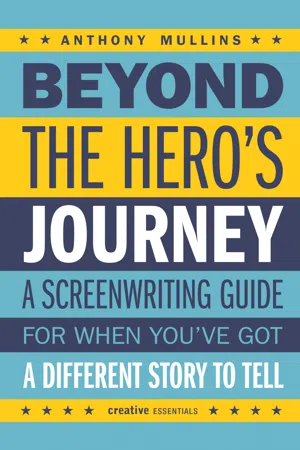![]()
PART I
ARC ANALYSIS
![]()
CHAPTER 1
‘You know who had an arc? Noah’: Understanding story using character arcs
The foundations of this book are built on the concept of character arcs, one of the most powerful tools in a writer’s toolkit. Character arcs map the shape of a story and its characters, as well as guide its tone and hint at its themes. In essence, character arcs are the ‘emotional shape’ of the story – they map how the character feels at the beginning, in the middle sections, and the end, of a story. To help you grasp the usefulness of character arcs, I’ve developed an approach I call Arc Analysis. It’s a technique that draws together the key dramatic principles writers use to shape their story without resorting to predetermined formulas like the Three-Act Hero’s Journey.
Character: Inside and out
When writers talk about a character arc, they’re talking about change. Does the life of the character change? How much does it change? Where do they start and where do they end? More specifically, an arc is about emotional change. Does the character change at an emotional level? How much do they change?
To understand how a character’s life changes emotionally, we need to look inside them. Imagine your character in two parts – their external world and their internal world. Their external world includes physical things around them that make up who they are: where they live, relationships, friendships, family, job, wealth, culture, nationality and even the natural environment around them. The character’s internal world includes intangible things that make up the emotional life of the character: hopes, dreams, fears, desires, goals, beliefs, values, etc.
There is a natural interplay between the external and internal worlds of the character, but at the beginning of the story, these two sides are in a type of balance. That doesn’t mean things are perfect – the character might be in a crappy job, a tired relationship or even in the middle of a war zone – but their life is, by and large, not changing. Whatever their circumstances, the character is familiar with their life as they know it. Their external and internal worlds are running parallel, like a river flowing within its banks.
Generally, a story starts when something changes in the external world of the character. It can be a bad thing, like losing their job or a relationship breaking down, or even good things, like winning the lottery or falling in love. The external change creates new or unfamiliar circumstances for the character.
When change happens, whether it’s good or bad, it creates conflict between the character’s internal world (beliefs, dreams, fears, etc.) and their external world (family, friends, society, etc.). These two parts of the character head in different directions, like a river that has broken one of its banks, forcing them to adjust to new circumstances. The tension created by these unfamiliar circumstances creates conflict in the story. Conflict is very important. It is the river that a story floats on.
If there is no external change and the banks of the river never break, there is no conflict. If there is no conflict, there is little drama and even less story. The conflict can be extremely big (the annihilation of the universe in Avengers: Endgame), incredibly small (the search for poetry in everyday life in Paterson) or anything in between. It is the gap between the external world of the character and their internal world that creates conflict and generates story. The bigger the gap, the greater the conflict.
When an external change occurs, it creates conflict that puts emotional pressure on the character. How do they feel about the change? What will they do about the conflict it causes? Will they try to fix it or ignore it? No matter what happens, the character needs to make an internal choice. That choice is guided by their internal world and reveals a lot about who they are, what they care about, what they’re afraid of and what they want. It goes beyond the words a character says and exposes what they choose to do under pressure. It is a tangible expression of their intangible emotional life.
Character and choice
In Western storytelling traditions, the concept of choice goes to the very heart of both character and story. It’s what writers use to bring their creations to life, as the internal thoughts, beliefs, fears and desires of their characters take shape in the form of a tangible action, a choice about what they will do to shape the world around them.
Generally I’ll avoid quoting beardy wise old men throughout this book (e.g., ‘Such-and-such said blah-blah so it must be true’). But since we’re talking about Western storytelling traditions, and this guy articulated many of the ideas that shaped those traditions, it seems only right to get his thoughts. His name was Aristotle (he only had one name, like Prince) and this is what he said about characters in a story;
‘Character is that which reveals moral purpose, showing what kind of things a man chooses or avoids. Speeches, therefore, which do not make this manifest, or in which the speaker does not choose or avoid anything whatever, are not expressive of character.’ (From The Poetics)
Let me translate. Basically he’s saying character is choice. They are inseparable. Until a character actually makes a choice between one thing or the other, it is hard to know who they are on the inside. Do they choose to fight or back down? Do they listen to others or reject advice? Do they keep their word or betray trust? Do they tell the truth when they could lie?
An idea like this really...



